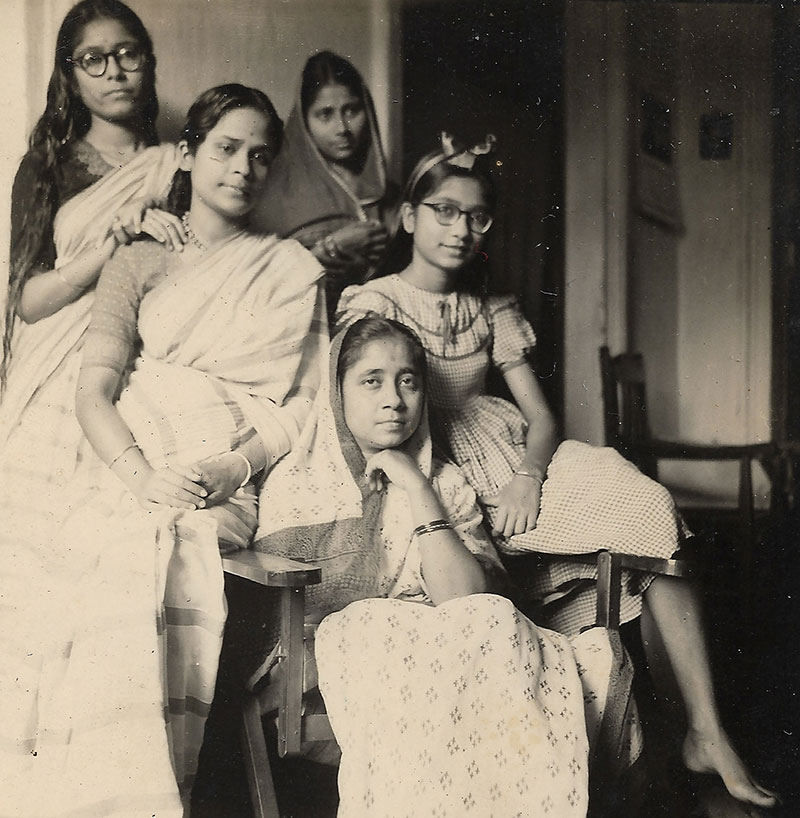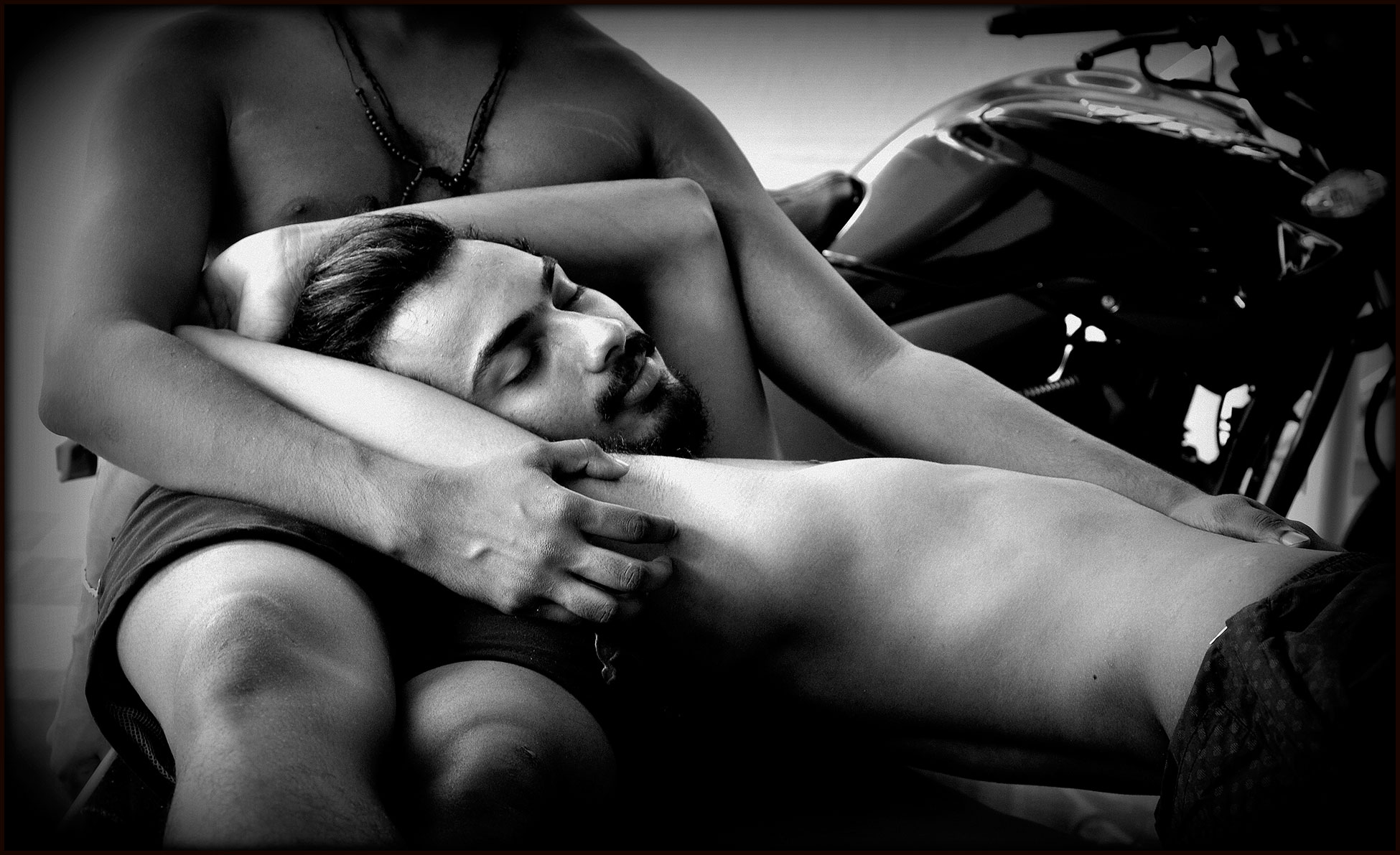Zoom In
Book Review
PhotoMail constructively and
Critically zooms into
The life and work of photographers
Its art and techniques
Contemporary theory
Aesthetics, material philosophy and
Sociology
Review of Pinney, Christopher
Camera Indica: The Social of Indian Photographs
London: Reaktion Books, 1997
Chicago: University of Chicago Press
1998. 240 pp
and
Ryan, James R
Picturing Empire: Photograph and the
Visualization of the British Empire
London: Reaktion Books, 1997
Chicago: University of Chicago Press
1998. 272 pp
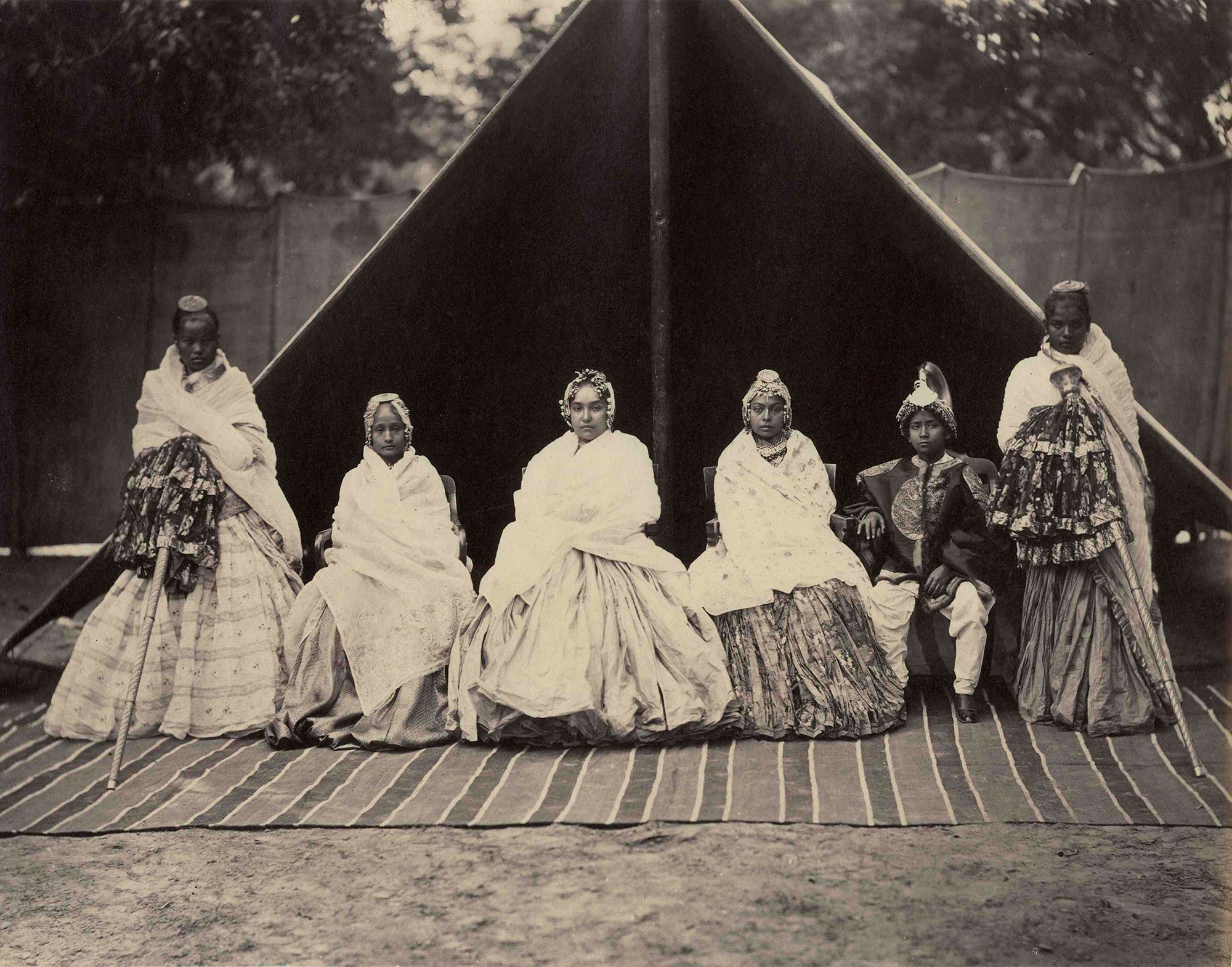
© Samuel Bourne, 19th century | Image Source Internet
The Burden (and freedom) of Photography
By Vinay Lal
The Tasmanian Aboriginals were rendered extinct in the second half of the nineteenth century, much less than one hundred years after they first came into contact with the white man. Decimated by disease, hunted by dogs, and shot by white convicts who were let loose in what was conceived to be terra nullis, the odd dozen Aboriginals who survived this onslaught of Western civilization were driven to a settlement near Hobart, where they were held in captivity. They were then photographed and, in a manner of speaking, ‘displayed’ in London at the International Exhibition in 1862. Doubtless, from the perspective of the white man, this was much better than being scalped, and the Aboriginals should have been grateful. But since natives are characteristically ungenerous, they slowly crept towards their death, and only a handful remained alive when the next round of photographs was shown at the International Exhibition in 1866. When James Bonwick’s Last of the Tasmanians was published in 1870, it included a photograph of an Aboriginal woman who, in the previous year, had become the sole remaining survivor. “Trucanini” herself died in 1876, the year that the one hundredth anniversary of the Declaration of Independence, many of whose signatories shared a family resemblance and close kinship ties with their marauding kinsmen in Australia, was being celebrated in the US.
Since then Trucanini has survived in ethnology albums, anthropological texts, movies, museums, and exhibitions. Her photograph, of a woman with graying hair and intensely sad eyes, stares at us – and it stares back from a hundred books. Once she was captured physically, pulled most likely by a rope slung around her neck; now she remains caged by the camera, and she will never be free of that festering captivity. She has been “salvaged”, and she exists as a troubled category of knowledge – as part of the fossil record of “humanity”. Among the plans that the Nazis hatched, let us recall, was one which allowed for the preservation of Jewish identity after the Final Solution had been achieved. A museum would be built to chronicle the history of the Jewish race. Killings should never come in the way of good science.
One suspects that photography hastened the death of the Tasmanian Aboriginals, as well as that of countless others among those who came under colonial rule. Unaware of how they were to deal with the indigenous peoples, unless it was to subject them to the sentence of death, the Europeans had no difficulties in assigning them places in museums. Here and there a race or tribe could be wiped out, but the European fetishism for classification, categorization, museumization, and ossification was viewed as furnishing more than adequate compensation to the natives who fell victims to the colonizers’ hunting instinct. Indeed, the hunting of “savages” was considered on a par with the shooting of animals; certainly both “savages” and “animals” belonged in a Natural History Museum, illustrations of the evolving and colourful story of evolution. As James Ryan details in Picturing Empire: Photography and the Visualization of the British Empire, the famous big-game hunter Major Chauncey Hugh Stigand, in his book Scouting and REconnaissance in Savage Countries (1907), furnished instructions on “tracking”, “stalking”, and “marking down” of animals and African “savages”; a later work on elephant hunting devoted an entire chapter to “Stalking the African”. Where Oriental potentates and senior colonial administrators proudly displayed tiger, leopard, and stag skins, the less powerful and affluent had to make do with more modest momentoes of their catch; photographs. Though photographs could be widely disseminated, unlike the real trophies they did not provide incontrovertible proof of masculine prowess: it was possible, after all, to have oneself photographed next to a dead tiger, and pretend that one had been the heroic agent of that death. Yet, over time, as the impression became widespread that hunting was perhaps not the most indelible marker of masculinity, it was suggested that it required greater courage and masculine prowess to draw up close to big cats and other wild animals, and shoot the camera at close range (pp. 130-32). Susan Sontag has described the camera as a “sublimation of the gun”, and Ryan reminds us that the vocabulary of picture-taking – “loading’, ‘aiming’, ”shooting’ – has been largely derived from hunting (p.99).
Holographs by Raja Ravi Varma
Ryan explores the place of photography in big-game hunting as part of his larger study of what Edward Said called the “imaginative geography” of the British empire and the work done by photography in surveying the land, enumerating and classifying the natives, waging military campaigns, opening the colonies to British explorers, travelers, and traders, and enhancing the pedagogic uses of geography. It was one thing to point out to school children on a map the areas of the world under the Union Jack, but altogether more impressive to provide a photographic record of the vast tentacles of the British empire. Ryan’s work is animated by the now-commonplace thesis that colonialism entailed far more than economic gain and military triumph: the colonized had perforce to be represented, as they were conceived to be quite incapable of representing themselves, and nothing was calculated to perform the work of representation better than photography. Enlisted in performing the various tasks of empire and giving imperialism succor, photography expressed and articulated the “ideologies of imperialism” (p.13). The Victorians, Ryan avers, invested a great deal in photography: not only was the camera a technological marvel, endowing its possessor with an inalienable right (again in Susan Sontag’s words) “to collect the world”, but it was an instrument of exactitude, absolutely “trustworthy” (pp. 17, 23-24). Ryan’s own work is founded on different premises: as he points out, it is imperative to understand how the authority ascribed to photography was constructed, and the manner in which photography creates the very objects it purports to represent. Photographs do not speak for themselves, Ryan states, and he similarly rejects the common- sense distinctions between photography, cartography, painting, and writing (p.19). An early photograph of the -“Dark Continent” depicted “a wall of impenetrable, twisted vegetation” (p.38), and similarly photographs of Abyssinia, taken by the British during the Abyssinia Campaign, showed barren landscapes, thereby implying not only that the British were largely conducting a war against the hostile forces of nature, but that there were no indigenous peoples in harm’s way (pp. 92-3). Considering the tenor of his own arguments, it is not entirely clear why Ryan rejects the view, other than to say it is “totalizing”, that photography is to a very great extent a “construction of discursive power” (p. 18). Where most studies of photography “fail to situate the images within their wider historical and cultural settings”, the Foucauldian-inspired colonial discourse analysis, Ryan argues, omits to take the images seriously, viewing them merely as another instantiation of power relations (p.19).
It is British explorers who carried the camera with them to Africa, India, and the Pacific islands. The camera was seen, predictably, as illuminating dark places, as probing the deep recesses of the native mind as much as the landscape, and as gifting the indigenous people with what David Livingstone called the “oxyhydrogen light of civilization” (p.31, 54). The scope of photography was truly imperial: as the pioneer photographer Samuel Bourne wrote in 1863. “There is now scarcely a nook or corner, a glen, a valley, or mountain, much less a country, on the face of the globe which the penetrating eye of the camera has not searched” (p. 47). Ryan rehearses the familiar argument that much of the endeavor was also to domesticate foreign landscapes (p.51), translate “unknown spaces into familiar scenes” (p.72), and render colonized territories more fruitful for commerce (p.65). The camera, accordingly, captured the advance of European civilization, an argument that Ryan encapsulates with terse descriptions of the works of British photographers in places such as Hong Kong, where the European settlements with their civic monuments were photographed as “beacons of light in an otherwise dark moral landscape” (p.67). John Lindst, who accompanied an expedition to New Guinea in 1885 as the official photographer, lovingly photographed a mission house as it offered irrefutable evidence of how “even in savage New Guinea the blessed light of the Word of God is gradually dispelling the darkness of barbarism and cannibalism” (p. 72). The camera was also preeminently the instrument for recording a nation’s essence: thus the Great Wall was described by the photographer John Thomson as expressing the insularity and deep hatred of foreigners encountered in China (pp. 68-9).
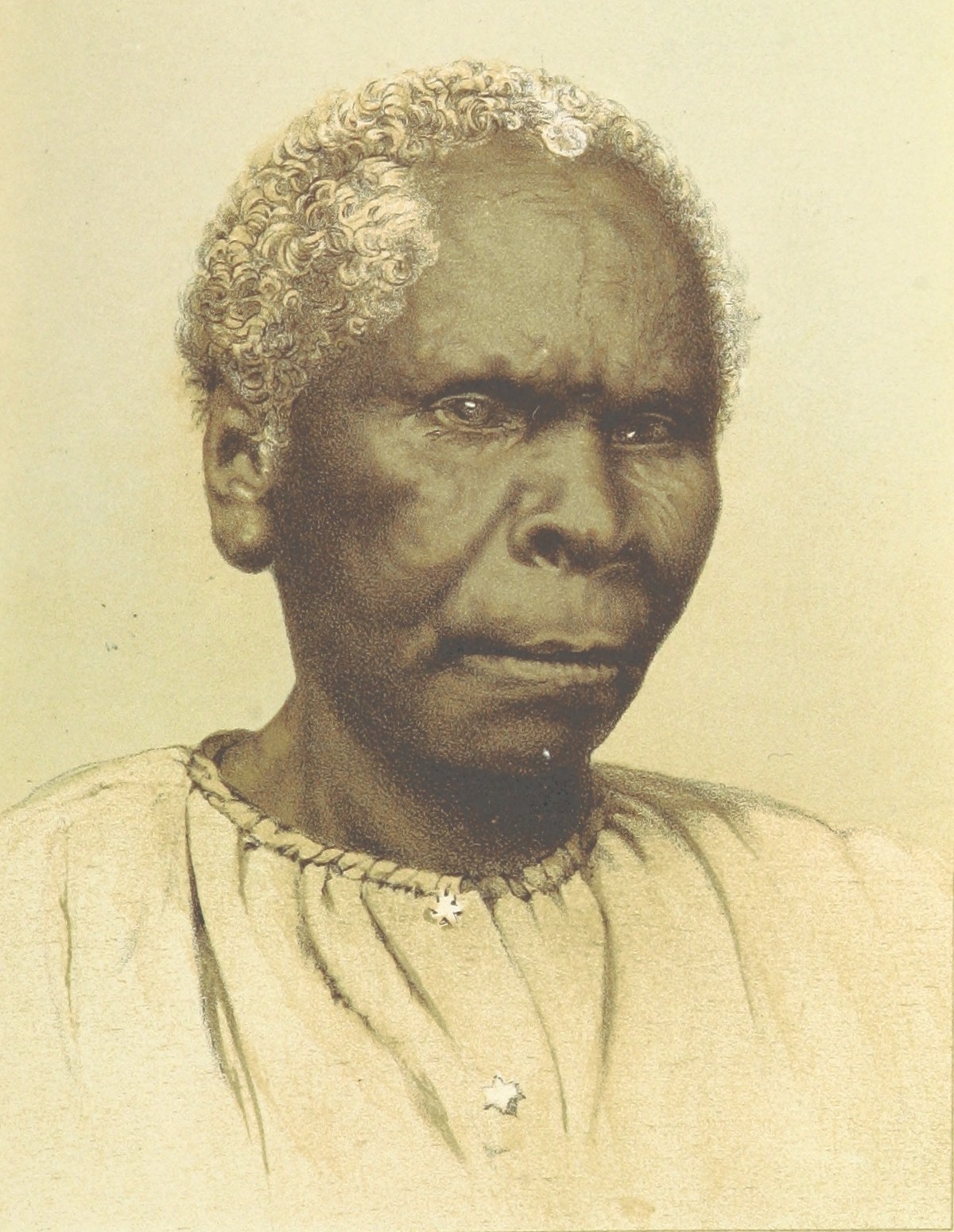
Trucanini, the last of Tasmanian Aboriginals who died in 1876
Nowhere is the association between colonialism and photography more clear than in the military applications of photography. Ryan focuses on the Abyssinian Campaign of 1867-68, but British India presents perhaps a richer terrain for understanding how photography serviced the military campaigns that were from time to time launched against rebellious or recalcitrant people or to present an appropriate show of force. The camera was introduced to India through the British army, and the pioneers of photography in India – John McCosh, Captain W.R. Houghton, Lieutenant H.C.B. Tanner, Captain H.J. Barr, and Captain L. Tripe, among others – were almost invariably military men.[1] In 1855, the East India Company had included photography in the curriculum at its Military Seminary at Addiscombe, but only after the Rebellion of 1857-58 were the official uses of photography to be fully explored, as the army routinely began issuing photographic equipment to its officers.[2] The massive photographic exercise in typology. The People of India, which had been initiated at the instance of Governor-General Canning, was transformed by the Rebellion of 1857 into an official project of the State, and placed under the control of the Political and Secret Department.[3] The Rebellion was surely not crushed by photography, but the British triumph at arms was made known through photographs that immediately received wide circulation: no Briton was likely to forget the heroic defense of the Residency at Lucknow, and similarly photographs of the attack on Delhi or the punishment inflicted on rebels were designed to impress upon the native the might of the British forces and their appetite for revenge. When, not long after the Rebellion, photographs were taken of Kuka rebels being tied to the mouth of the cannon and then blown to bits, Indians must have been suitably struck by the long arm of British chastisement. Samuel Bourne, who arrived in India in 1863 and produced a series of photographs of Kashmir and the Himalayas, openly expounded on the terror that photography could inflict on the colonized: ‘From the earliest days of the calotype, the curious tripod, with its mysterious chamber and mouth of brass, taught the natives of this country that their conquerors were the inventors of other instruments besides the formidable guns of their artillery, which, though as suspicious perhaps in appearance, attained their object with less noise and smoke” (p. 75).
The lengthiest chapter in Ryan’s book is on the deployment of photography in anthropometry, ethnology, and anthropology, on photography and the depiction of “natives” and the poor of London alike (pp. 140-82), but here he traverses territory familiar to many scholars. It is this chapter which intersects most closely with the work of Christopher Pinney, particularly the first chapter of Camera Indica: The Social Life of Indian Photographs. In one respect, Pinney’s canvas is not so wide: where Ryan considers the uses of photography in the geographic expanses of the British empire, Pinney offers a fragmented history of photography in India; where Ryan relies on the trope of spatiality, Pinney ruminates on the altered notions of temporality introduced by photography; where Ryan stresses the association of photography with geography, Pinney reflects on photography and its place in the construction of history and memory. Camera Indica is, of course, an allusion, even homage, to Roland Barthes’ Camera Lucida; yet, as Pinney says, “at the very moment of genuflection” he seeks to “move away from the insular security of the Euro-American cultural region – the ground upon which nearly all work on photography has been built.” The botanical reference, likewise, is somewhat misleading, for Pinney’s interest lies not only in questioning the taxonomies which inform the study of photography, but in endeavoring to provide a view of the “complex changing ecology of photography” (p. 8). lt is this “ecology of photography” which beckons us to take seriously the view, which was expressed often by clients in the small town of Nagda in central India where Pinney did his field work, that they would pay a full fee for full-length portraits, half the fee for half portraits, and only a quarter for headshots (p. 9); it is the same commitment to the ecological survival of plurality, and not only the anthropologist’s fetish for finding an enclave that he can claim as his own, which suggests why Pinney finds the work of studio photographers in an obscure Indian town as full of insights for a more nuanced history of photography as the celebrated photography of an Ansel Adams or a Sebastian Salgado.
Pinney begins, conventionally enough, with photography in the colonial period – but this is by way of moving from “taxonomy” to “ecology”, as shall presently be seen. Though Pinney comments on the importance ascribed to visuality in modern societies, he argues that visuality assumed an even greater place in India, since the other signs by which India might be read were seen as being “unreliable, mysterious and deceptive” (p.17). The British held widely to the view that no native could be expected to abide by the truth; texts had been deliberately distorted by the conniving Brahmins, and all evidence proffered by natives was tainted. Photography, by contrast, fulfilled the yearning for a “stern fidelity” – it proposed to offer to the colonial gaze an India that could be surveyed, explored, mined for revenue, indeed an India that could, in a manner of speaking, be seen and possessed stripped of its inhabitants, or an India where the natives could, along with the flora, fauna, natural resources, and cultural and natural landmarks, be enumerated, categorized, and rendered fit as specimens for a Linnean-type of investigation. The principal virtue of photography was that it enabled the colonial state, as it thought, to know the native; and this was no mean achievement, as the native was slippery, elusive, full of deceitful intent. Pinney describes at considerable length the complex points of intersection between photography, fingerprinting, and anthropometry in the colonial regime of disciplinary surveillance and regulatory knowledge. Daniel Ibbetson, who held high office in Punjab, championed anthropometry: pointing to the difficulties in obtaining by mere verbal enquiry “a full and accurate statement of custom” from “Orientals” and “still more, from semi-savages”, he described “cranial measurements” as “almost absolutely free from the personal equation of the observer” (p. 21). Others, such as Norman Chevers, spoke prophetically if not eloquently of the future of photography, which would “be employed throughout India as a means of identifying bodies” (p. 21). Fingerprinting, which first developed in India, was advocated by the police: it made possible the identification of criminals, and so robbed the native of his mastery at disguise. The “defective” paradigm was one of the two that predominated in colonial photography; the other paradigm proposed to “salvage” the native, putting on photographic record all those communities and tribal groups that faced extinction or were rapidly being denuded of their special characteristics (p.45). Throughout Pinney is at pains to stress that colonial photography was interested not in Indians as individuals, but as specimens of “types”. The subjects who sat for the aforementioned People of India project were merely illustrations of a general type, representatives of a wider group – call it “bunneas”, “Brahmins”, “Gujars”, and so on. In this respect, as in so many others, photography comported well with the broad outlines of the colonial sociology of knowledge.[4] In India, on the colonial view, individuals did not exist; one could only speak of communities, principally in terms of religion, caste, and race. India was a conglomeration of “types”, and photography was most effectively utilized in eliciting and documenting these “types”. At the macro-and micro-level alike, India lacked a history.
From his long initial chapter, Pinney moves on to a brief albeit insightful discussion of the manner in which Indians embraced photography, and their repudiation of some aspects of its colonial legacy (see p.225 n.17). Whether photography spoke to the sense of the visual in premodern Indian culture, or whether it betokened something magical and alchemical – all of this Pinney leaves unexplored, though he points to the ready uses of photography in representing gods and goddesses. Early Indian photographers reproduced colonial photographic practices, but already, by the manner in which they were deploying paint on pictures, they were showing their departure from European traditions. They often did not merely touch up their negatives, or use paint as a supplement; rather, the paint “even” obscured the photographs (p. 79). Where the colonial fixation on “types” betrayed anxiety about preserving the order of Indian society and the purity of taxonomies supposedly derived from Western science, the practice of overpainting photographs raised another order of anxiety about pollution: in the words of Judith Gutinan, author of Through Indian Eyes, “painting on photographs suggests a kind of impurity – on the one hand, an excuse for failing to reach more perfect heights, on the other, a device for watering down what should be a purely photographic statement’ P.82). The Indore State Photographers, Ramachandra Rao, and Pratap Rao, produced “photographic prints of paintings of mythological subjects”, and their images, as those of other Indian photographers, “spring from a representational strategy that is concerned not with categorization and the closure of identity [as was the People of India project, or the anthropometric photography of colonial administrators, ethnologists, and census-takers] but with the manipulation of a repertoire of signs signifying possible states of being” (pp. 88, 91). Their work gestures at almost unself-conscious forms of hybridity; it has room within it for a wider conception of being oneself, and it suggests different modes of transcendence. Pinney argues, further, that the Indian conception of photographic portraiture was not based on the idea of “moral physiognomy”, or the idea, captured for instance in H.H. Risley’s formulation of the “nasal index”, or in Johann Casper Lavater’s claim that structural features of the face unlocked the character of a person, that the moral worth of a person could be deduced from his or her external characteristics. Indian ideas, which are played out in photography as in other domains, were determined more by the indigenous notion of darshan, which entails a dialectical interaction between the gaze that the human directs at the divine and the gaze directed at the human by the divine (p.106). The local people with whom Pinney spoke in the town of Nagda distinguished between the notion of vyaktitva, which refers to the external characteristics of a person, and charitra, which is a reference to the biography of the soul, a voyage into moral interiority; and they were quite adamant in stating that photography had nothing to say about a person’s charitra (pp. 198-99).
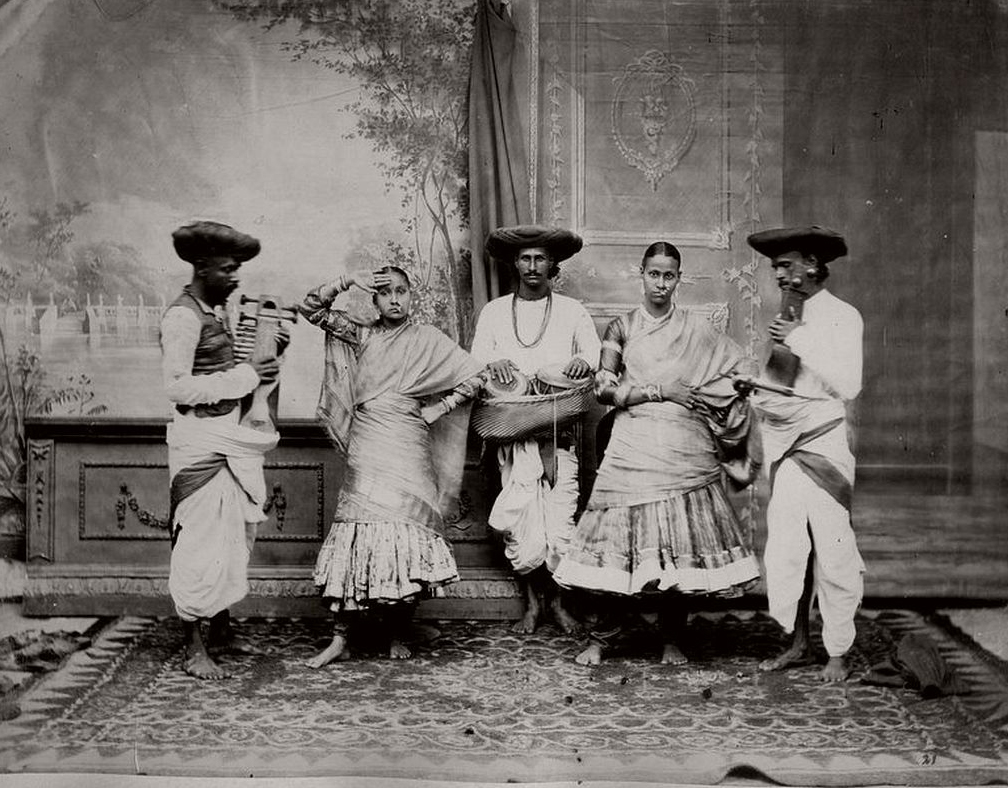
Ladies in Kashmir by Samuel Bourne 1865
It is in the third chapter (pp. 108-209), which comprises half his book, that Pinney takes the reader into more promising and enticing directions, and so puts on offer a work on Indian photography that is unusual for its daring, imagination, and politics. A slightly more detailed sociological portrait of Nagda, which has six main studios, might have helped the reader to understand how far this town is characteristic of urban and semi-urban settlements in north and central India, and whether the photographic practices he discusses as prevailing there are likewise ‘typical’ or somewhat anomalous. The point, quite simply, is that the work to which Pinney devotes his attention has never before been considered worthy of study, and his exploration of the everyday world of Indian photography shows unequivocally that imagination and innovation are scarcely the prerogative of those with formal training in photography or access to the work of world-class photographers and galleries. Pinney offers a detailed account of how Nagda photographers make their living; the advent of video; wedding photographs; tourist photography; the use of photographs at home and for worship; and common technical features of Indian studio photography, such as painted pictures, composite color prints, collages, and superimpositions. The social history of the photographs is not always satisfactorily drawn out, but nonetheless the subtitle of Pinney’s work, “the Social Life of Photographs”, is not to be taken in jest, as one of those obligatory invocations of “social”, for his photographs take us into living rooms, the fields of the farmers, and the interior lives of people.
Among the most interesting discussions is one on temporality. When video first came to Nagda, still photographers found themselves being marginalized; but for a variety of reasons, the initial euphoria greatly subsided, and beginning in the early 1990s families once again opted to have marriages in the family documented by still photographers. Drawing on the work of the French semiotician of cinema, Christian Metz, Pinney argues that a photograph allows the viewer to linger on it, wh‘ereas the “video spectator” is the prisoner of a “temporal regime” wherein she or he has little control. He quotes approvingly Metz;s dictum, “Where the film lets us believe in more things, photography lets us believe more in one thing” (p. 124). Another dimension of temporality is introduced by Pinney’s suggestion that the wristwatch in Indian photographs can be read as an overt and oracular display of power, not only as a sign of the “modern’ (pp. 177-78). Pinney takes us a long way from the colonial notion of “moral physiognomy” and the “typology” of races, as the discussion of a famous photograph, based on an original lithograph, of the freedom fighter Chandrasekhar Azad shows. In the most standard representation of him, Acad is shown with the sacred thread of an upper-caste Hindu across his bare chest, twirling his moustache and sporting a large wristwatch. In calendar images, Azad, who was killed in an encounter with the police, is often shown with Bhagat Singh, who was sent to the gallows and is revered as a martyr to the cause of Indian independence. Azad was a Hindu, Bhagat Singh a Sikh, and Britons conditioned by “anthropometric obsessions” would have expected a “fundamental difference” between them, “a separation that could be testified by sartorial, physiognomic and physiological incompatibility.” Yet, in popular representations, largely the work of a Muslim artist, H.R. Raja, Azad and Bhagat Singh appear identical, distinguished “only by the presence of a hat [on Bhagat Singh] or a wristwatch and sacred thread”. This image, Pinney argues, “suggests an oppositional practice, a political critique of the divisiveness of British policy and much of its imperial science” (p. 209).
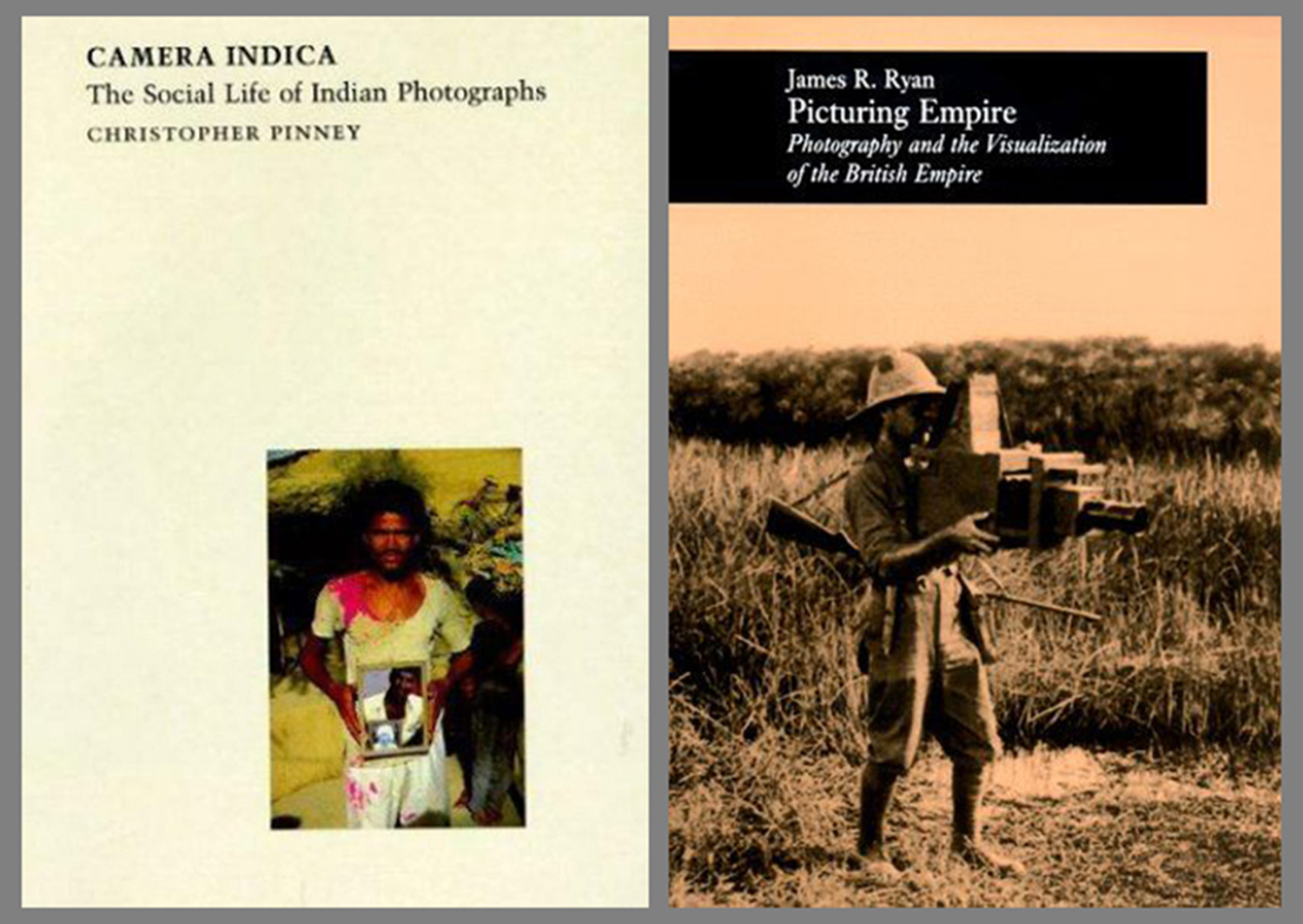
Book Covers | Camera Indica: The Social of Indian Photographs and Picturing Empire: Photograph and the Visualization of the British Empire
Enticing as is Pinney’s discussion of Nagda portraiture, he stops short on occasion of asking fundamental questions about the cultural politics of representation. Among the many photographic practices that Pinney encountered in Nagda, the use of multiple framing is striking. The cover of the book depicts a man, Ramlal, holding a framed photograph; within that frame, his brother, Hira, who was killed by a train, is shown holding another framed photograph of their father, Ganpat. Pinney has nothing to say about the possible indigenous inflections of this representational practice. Might it have something to do, for instance, with the common Indian narrative strategy, encountered in the Panchatantra, the Puranas, and the Mahabharata, of the story within the story within the story? Similarly, Pinney does not allow the multiple, simultaneous notions of time which are the bedrock of the Puranas to inform his discussion of temporality. Far more than most social historians, Pinney allows that Indian categories have something vital to tell us about photography, but his discussion of bhav (emotion or sentiment) is quite inadequate. The marvelous photograph of members of the family of one Ragu Ravidas in front of a “heavily coiffured Shiv” taken in a traveling studio in Nagda attests to Pinney’s richly nuanced understanding of how divinities enter into (and exit from) photographs, but he does not push his query far enough to ask: what do photographs do to Indian gods of goddesses? do they give birth to them and allow others to die? But that Pinney’s book even encourages us to frame questions in this fashion is a sign of how far superior it is to any work on Indian photography and indeed to most social histories which take “India” as their subject.
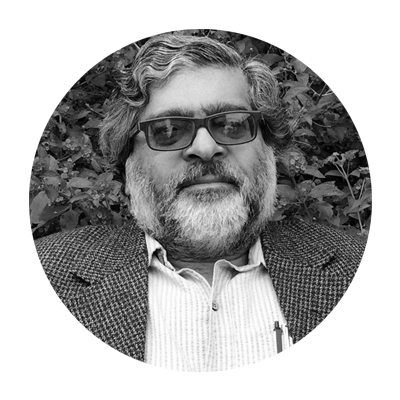
Vinay Lal is a cultural critic, writer, blogger, and Professor of History at the University of California, Los Angeles (UCLA). His 18 books include Empire of Knowledge (2002), The History of History (2003), and The Fury of Covid-19: The Politics, Histories, and Unrequited Love of the Coronavirus (2020).
Published on February 9, 2021
Share
Related Articles

In my taxi, when a photo artist becomes a cab driver
What motivated Weideman to keep photographing? The answer to this is also an important quality that makes his photographs intriguing. He continued shooting even though he was not exhibiting nor getting into any sort of limelight until the mid-90s. Passion for the medium, of course. But there is more.
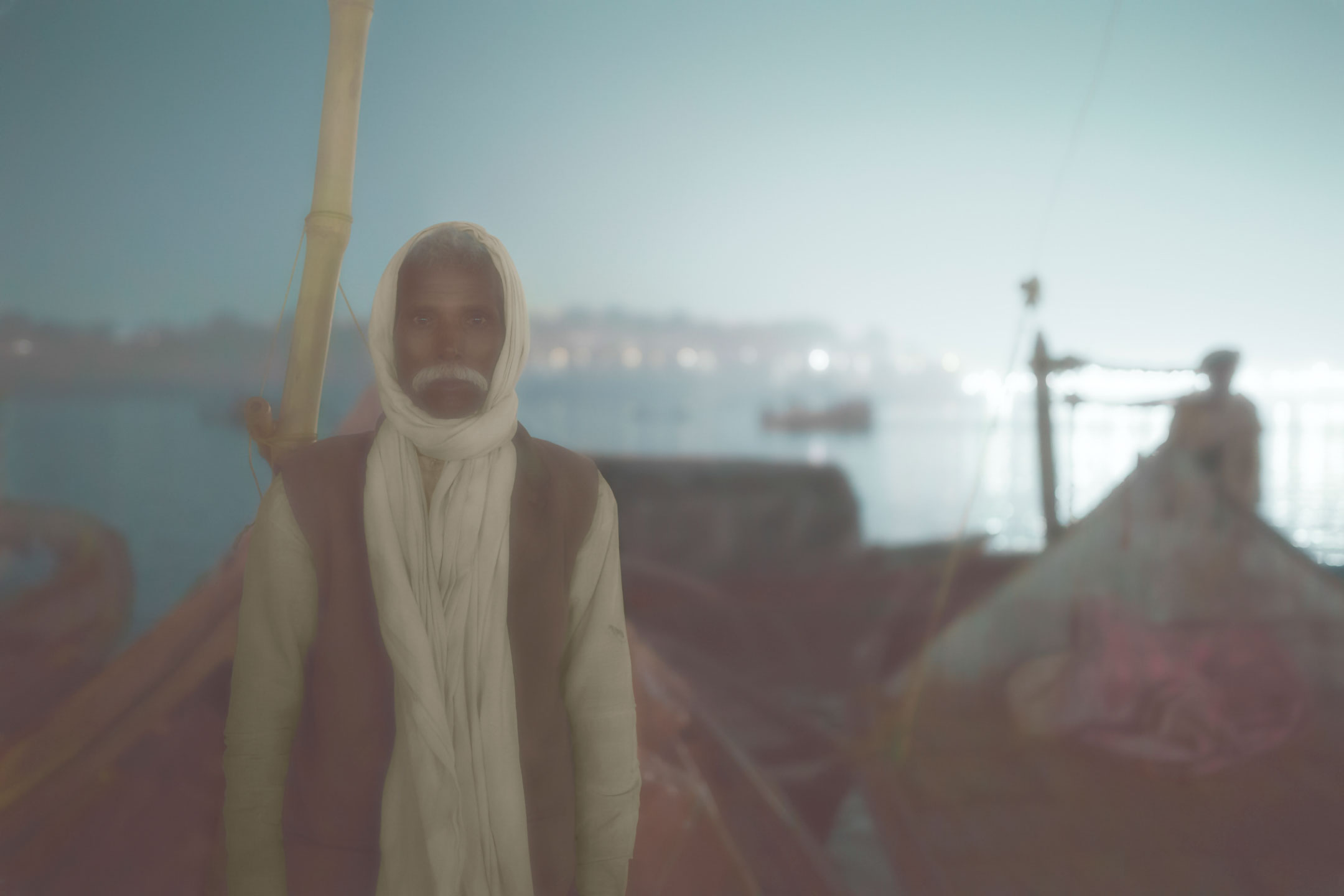
Mallaahs, the boatmen of Gangetic geography, A Photo Art series by Shibu Arakkal
Review of Mallahs, the boat of Gangetic geography, photographic series of Shibu Arakkal. For several hundred years these boatmen on the Ganga and the Yamuna have handed down their oars from father to son. I was intensely drawn to the purpose of their lives, to carry people back and forth on these rivers. Almost married to their boats, these men. To live almost all of their lives on these wooden vessels, going about their worldly chores and belonging to a tribe of menfolk, they pride themselves on being the real caretakers of these mystical rivers. Almost as if they are born on these boats and just as possibly may breath their last on it, the Mallaah men live lives removed from their families and children.
In search of the lost home
Across the world there are ongoing attempts to construct a ‘people’s history’ through photographs. Memory Projects, they are fondly called, focus mainly on the pre-digital era when photography was not as common as today. Bengali photographer Anandarup Goswami’s photography series ‘A Home of No Return’, though not directly linked with any memory project, shows certain resemblances with the latter’s style, and yet carries its own soul. A Home of No Return visually narrates the past and the present through a mixture of faded and fresh photographs.
Homomorphism II
The LGBTQ community has found for itself public spaces in urban regions. We will wait and see what they want to tell the world from that space. After all, solidarity with the cause does not mean solidarity with the acts, and it is time for the community to begin to act convincingly. This exhibition is a good starting point, and further on, there is a desperate need for clarity on the part of the activist-artists.

Elements and Fragments, Uncovering Narratives of a Temple Town
Inasmuch, every photographer that ever visited Tiruvannamalai never took notice about anything other than Ramana and the Annamalaiyar temple – their eyes glossing over everything else and their focus devoted entirely to the two ‘divine’ icons. But, there remains a Tiruvannamalai beyond, which has gone unnoticed and undocumented – invisible to the colonial gaze that is pre-occupied with its exotic fairy tales, and underwhelming for the photojournalist due to its perceived mundane-ness.





